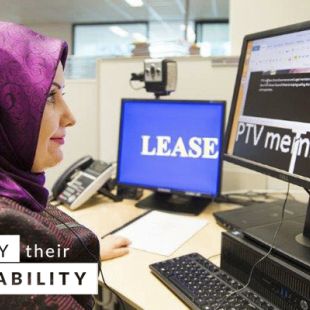Blind and low vision support at work
A person who is blind or has low vision may need to do some tasks in a different way to sighted employees. But that doesn’t mean they can’t do the job.
There are many ways you can support employees who are blind or have vision loss. This might include simple changes to work areas and tasks or using assistive technology. You can also get funding for workplace adjustments.
Blindness and low vision at work
How a person’s level of vision affects their work can vary. It can depend on:
- how well they know the job or task
- the assistive technology available for them
- the support at work.
Blindness or low vision may affect an employee ability to read, uses a computer, drive, operate machinery and handle money. It may also affect how they move safely around the workplace.
Understanding blindness, low vision and eye conditions
Complete vision loss or blindness means severe loss of vision or having no vision.
The term ‘low vision’ means a person has some sight loss. A person with blindness or low vision may use a white cane, guide dog or a GPS device to help them get around.
Someone who is colour blind is not blind but their condition affects how they see some colours.
For more information on blindness and low vision the healthdirect website. You can find information on Deafblind Australia’s website.
Making workplace adjustments to support your staff
There are ways to help employees with vision loss to better manage at work. This could include changes to work tasks, methods and work areas. Changes you make will depend on what the employee needs.
Changing workspaces
Workplace modifications you might make for an employee who is blind or has low vision include:
- using markers or signs that you can touch
- marking edges of steps so they stand out
- checking lighting to make sure it meets Australian standards
- adding lighting for specific tasks for extra brightness or contrast
- placing all items employees use often within easy reach
- moving workstations or putting up blinds or curtains to avoid glare. Employees working outside can wear hats or sunglasses
- facilities and changes to help employees with guide dogs.
Orientation training may also help employees to get to know the workplace.
Providing software and equipment
You can also support staff with assistive technology and devices, such as:
- software to help make computer displays bigger
- text to speech software on computers and mobile phones
- larger computer monitors to help with viewing text and changing contrast, colours and brightness
- aids and devices to magnify documents
- scanning software so employees can scan hard copy documents to view or listen to on screen
- braille equipment or barcode scanners, which you can use to label items
- large button phones
- GPS equipment or mobile phone GPS apps to help employees get around when travelling for work.
Changing work tasks and methods
The employee who is blind or has low vision will likely have their own strategies and can tell you what they need. Examples of changes you might make include:
- helping employees who need to tell the difference between colours, or not giving them colour dependant tasks
- letting employees take regular eye rest breaks.
Financial support for workplace changes
The Employment Assistance Fund (EAF) helps fund work-related changes. It pays for modifications, equipment and services to help people with disabilities get a job and keep a job. To work out if your employees are eligible, see the full guidelines.
Useful Downloads
Related pages
Last updated:
Meet Neslihan Sari, Paralegal at Public Transport Victoria
For Neslihan Sari, Paralegal at Public Transport Victoria (PTV), employing people with disability has far reaching benefits.
